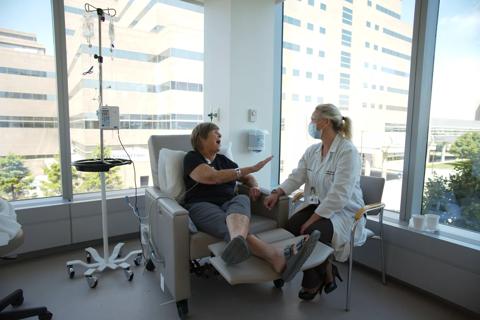Innovative unit dedicated to managing population health

Announcing a one-of-a-kind leadership position within Cleveland Clinic’s newly created population health unit, Ruthann Gavrilescu, MSN, MEd, BSN, has been named the unit’s Senior Director of Nursing.
Cleveland Clinic is a non-profit academic medical center. Advertising on our site helps support our mission. We do not endorse non-Cleveland Clinic products or services. Policy
The population health unit, also known as Cleveland Clinic Community Care, came to fruition in late 2017. Highly innovative, the unit is focused specifically on population health management, primarily in Cleveland Clinic outpatient ambulatory settings. Outpatient areas within the unit follow a model of care that is increasingly dedicated to maintaining and improving community health through wellness and prevention measures.
Currently, the unit encompasses adult primary care, pediatric primary care, express clinic care and at-home medical care across Cleveland Clinic’s 18 full-service family health centers, 10 regional hospitals and seven nurse-led chronic care clinics. It also includes Cleveland Clinic’s comprehensive Nurse on Call program, care coordination teams and Quality Alliance group, which is an integrated network of independent community physician practices that affiliate with Cleveland Clinic for quality and standardization.
As Senior Director of Nursing, Gavrilescu will oversee nursing operations in each of these areas. She will lead the practice of approximately 2,000 Cleveland Clinic nurses and medical assistants – from triage nurses to ambulatory infusion nurses, licensed practical nurses (LPNs) who help run the chronic care clinics, and more. She will also be responsible for managing all functions of care coordination and transitions of care across the continuum.
Gavrilescu is supported by a team of four nursing directors – each dedicated experts in the following areas: ambulatory care nursing, infusion nursing, procedural care, triage nursing, care coordination and transitional care management.
And further, Gavrilescu will collaborate with her Cleveland Clinic nursing colleagues in the Office of Nursing Education and Professional Development and the Human Resources Department to: 1) enhance ambulatory nursing education at area colleges of nursing to better prepare student nurses for population health management; and 2) ensure Cleveland Clinic’s new nurse hiring practices and nurse residency program effectively reflect the needs of population health management.
“Ruthann has built her career in the ambulatory setting and she excels at leading innovative process initiatives in a continuous improvement environment,” says Kristine Adams, MSN, CNP, Associate Chief Nursing Officer of Care Management and Ambulatory Services. “For 18 years, she has been a highly respected nursing professional with the Cleveland Clinic health system. She has the experience and know-how to perform exceedingly well in this unique position and to execute this new vision of healthcare.”
The primary goal of the population health unit is to make care more efficient and affordable by keeping people healthier. It is designed to create value while lowering healthcare costs through exceptional patient experiences and outcomes; i.e., giving people the care they need when they need it and preventing future disease and hospitalizations.
The unit operates like one of Cleveland Clinic’s medical specialty institutes. Primary care providers, specialists, home healthcare providers, rehab and skilled nursing facilities, pharmacists, registered nurses, care coordinators and other caregivers work closely as intercollegiate partners to identify and treat patients earlier and better manage chronic conditions. Caregivers practice at the top of their license to contribute the highest skill levels in the most efficient way.
Creating the new population health unit required numerous health system leaders and caregivers spending many hours developing comprehensive strategic plans to do the following: restructure resources, standardize staffing, skill mix and processes; produce onboarding and training curriculum (aka STAMP: Strengthening Teams And Managing Populations); design and implement new technologies; create robust predictive analytics tools and models; establish complete metrics and financial reporting processes, and enhance communications to improve synergy between caregiver areas.
“After several years of incredible work, the move to formalize population health management at Cleveland Clinic reflects a proactive approach to a less expensive, more effective healthcare system,” Adams says. “The challenge with population health is you have to give it time to play out. Changes aren’t realized immediately. For example, when the state of Ohio expanded Medicaid and gave first-time patients access to vaccines, mammograms, colonoscopies and other preventive care measures, it took roughly 2 to 3 years to realize reduced costs because of decreases in breast and colon cancer.”
While the quality and outcome metrics of the new unit may take several months or even years to realize, success is highly anticipated and will be measured against a number of regulating bodies and governing agencies, such as the National Committee for Quality Assurance (NCQA) Healthcare Effectiveness Data and Information Set (HEDIS) and the Centers for Medicare and Medicaid Services (CMS) Star rating system.
As part of an Accountable Care Organization (ACO), Cleveland Clinic will continue to achieve and report on specific quality and patient experience measures to demonstrate that the health system is keeping patients healthy and taking care of them if they get sick – providing the highest quality patient-centered care while staying within an established budget.
Gavrilescu was officially appointed to her position in November. Prior to accepting her new role, she served as Cleveland Clinic’s Nursing Director for Regional Ambulatory Operations.

Amanda Clark uses leadership skills to improve local healthcare access, mentor colleagues

Caregiver thrives despite the challenge of profound hearing loss

Mercy Hospital welcomes new chief nurse

New Lutheran Hospital CNO values quality and evidence

Nurse practitioner is a big believer in patient-caregiver collaboration

Leadership sectors include APRN and nursing quality

Fast-paced nursing environment full of reward

Experienced nurse leader Shannon Pengel appointed